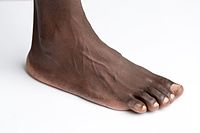
Photo from wikipedia
Previous studies have reported that vibrotactile stimulation of the nail of the hallux decreases the variability of the center-of-mass (CoM) movement in the lateral direction in subjects performing unsteady walking… Click to show full abstract
Previous studies have reported that vibrotactile stimulation of the nail of the hallux decreases the variability of the center-of-mass (CoM) movement in the lateral direction in subjects performing unsteady walking on the spot. This study investigated the effect of vibrotactile stimulation of the nail of the hallux on the CoM movement during walking. Healthy young males were asked to walk with and without stimulation, and their CoM was measured. The intrasubject mean and coefficient of variation (CV) of their walking speed, stance time, and CoM movement were evaluated. The differences between the variables with and without stimulation were determined, and the baseline-dependent effects of the stimulation on these variables were analyzed. It was observed that stimulation had a negative baseline-dependent effect on the CVs of the walking speed, stance time, and the CoM movement in the lateral direction. In particular, stimulation decreased the CV of the CoM movement in the lateral direction for subjects with a greater variability. Vibrotactile stimulation of the nail of the hallux can reduce the variability of the lateral displacement of the CoM movement in healthy young subjects who otherwise show a large variability of the CoM movement during walking without stimulation.
Journal Title: Applied Sciences
Year Published: 2020
Link to full text (if available)
Share on Social Media: Sign Up to like & get
recommendations!